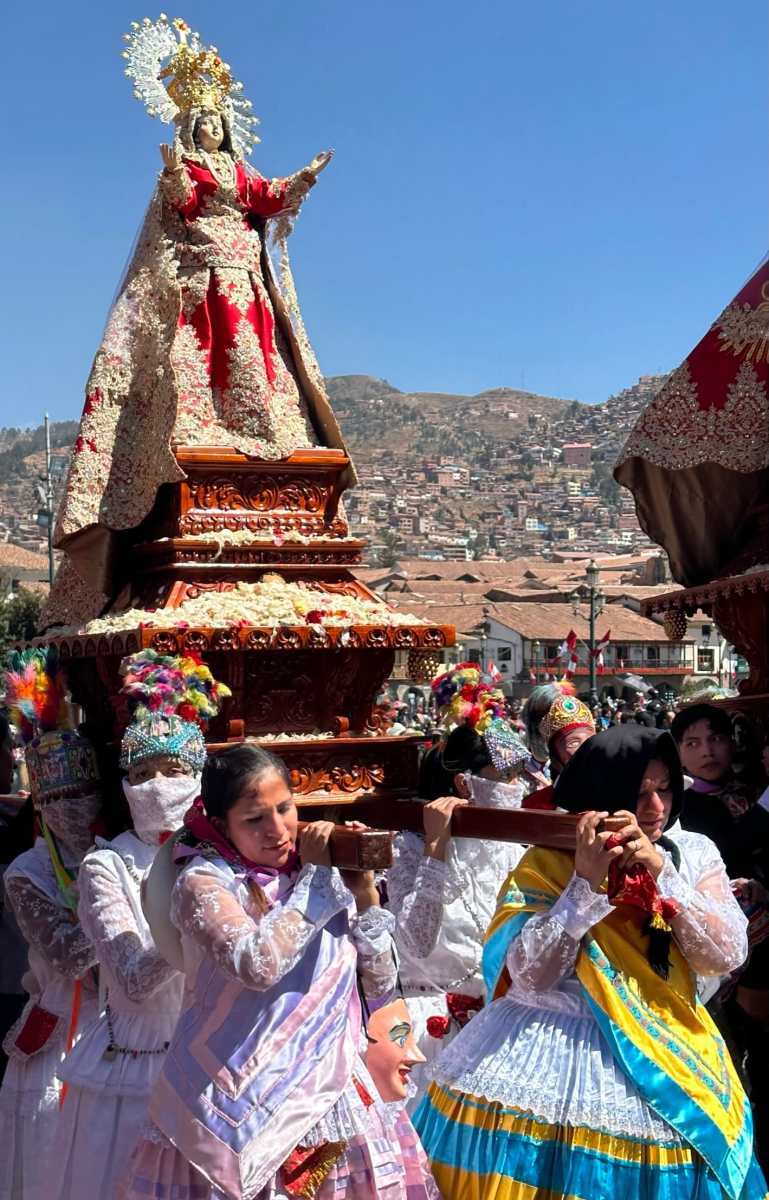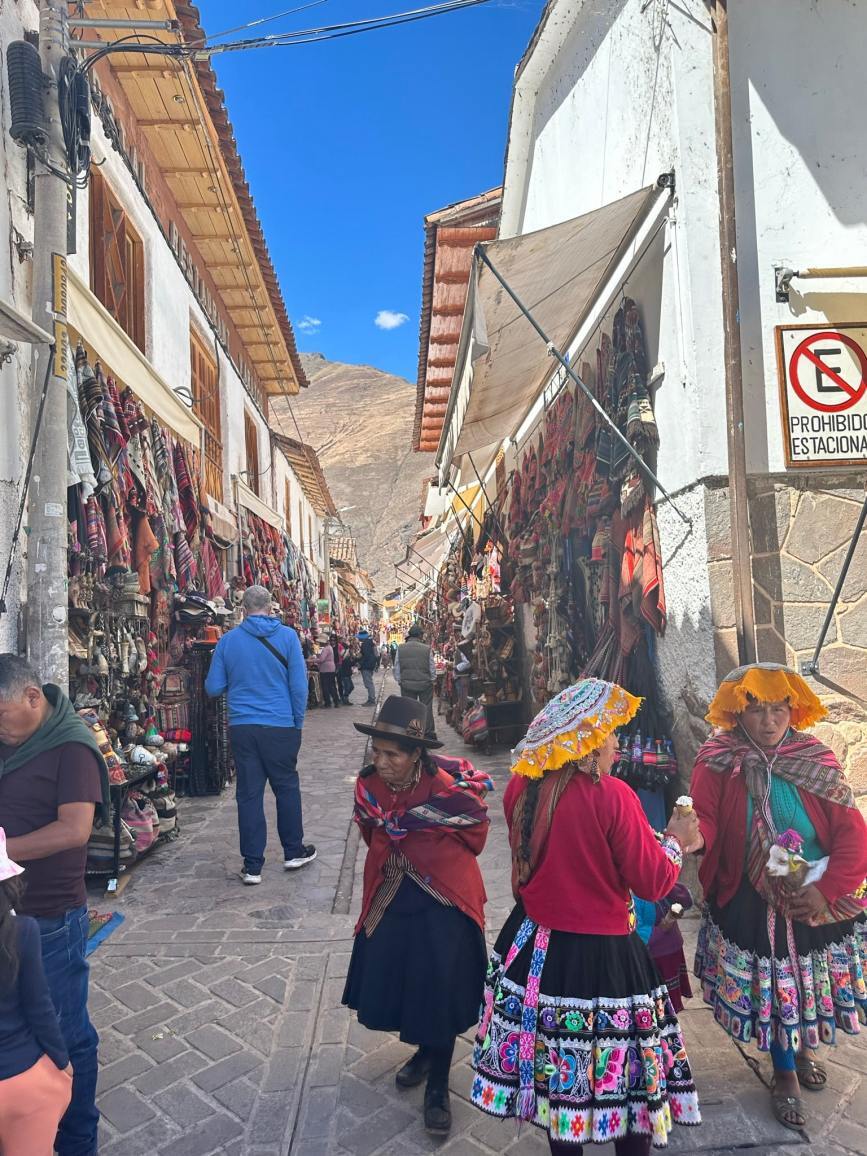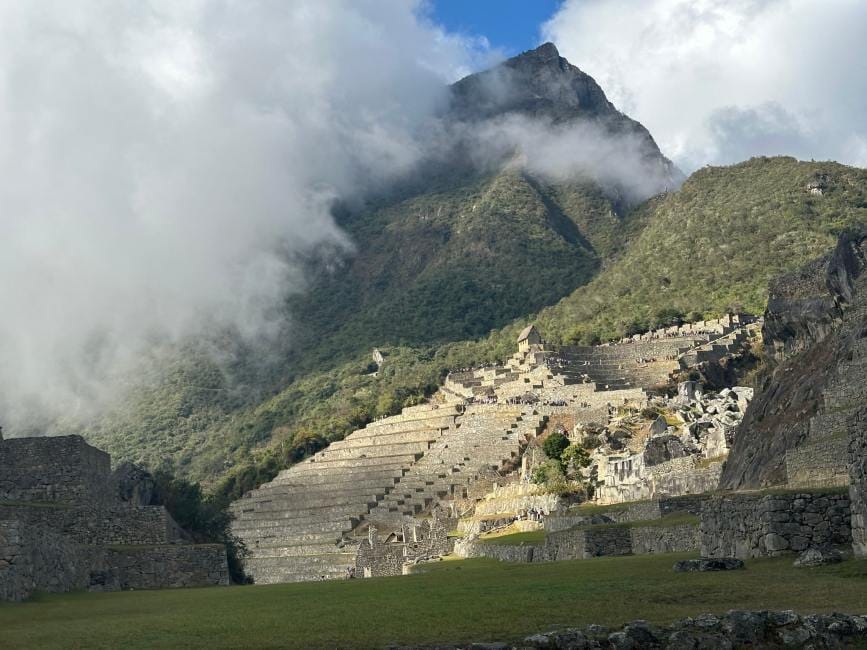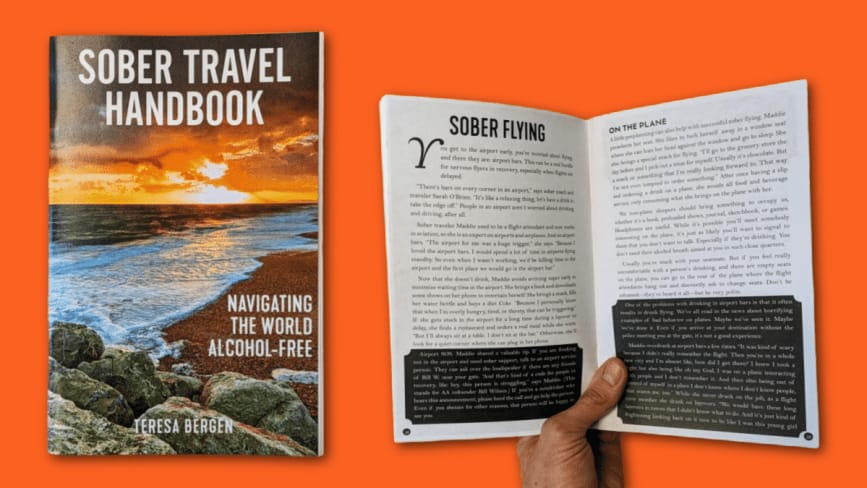- The Sober Sip powered by The Sober Curator
- Posts
- What a Trip! See Machu Picchu Sober!
What a Trip! See Machu Picchu Sober!

The hike took seven hours, and we gained 1800 feet of elevation in the first three. Huffing and puffing, we climbed through cloud forest, passing orchids, ferns and a glorious waterfall. Sometimes we walked on dirt trail, sometimes we climbed old, uneven Inca stone steps. The last 52 were so steep we had to crawl.
At last, we reached the Sun Gate and saw it in the distance: Machu Picchu! Our little group of sober hikers had survived the arduous climb and could reap the reward of visiting this 15th century archeological site. It was the pinnacle of a wonderful weeklong trip to Peru’s Sacred Valley with Choose Life Sober Adventures.

Peru had gazillions of adorable, woolly llamas. We wanted to pet them all. Photo by Teresa Bergen.
Hiking, Culture and Archeology
Choose Life’s tour of Machu Picchu and the Sacred Valley combines archeology, culture and being active. We met up in Cusco. Fortunately I arrived a couple of days early because the elevation hit me hard. I’ve been to some high places in the Andes before, but landing at 11,000 plus feet was a bigger deal than I expected. I settled in at the gorgeous Hotel Abittare, which I found out had the extremely welcome amenity of an oxygen tank wheeled to your room. At no extra charge.
Aside from elevation sickness, I found Cusco a vibrant and interesting place. As members of our group began to arrive, we walked many loops around the old part of town. Ladies in traditional Andean garb enticed visitors to take photos with their extremely well-groomed llamas. Street entrepreneurs hawked ponchos and massages. And everywhere, it seemed, impressive churches had been built over even older temples.

The city llamas were fancier than their country cousins. Photo by Teresa Bergen.
We were a group of nine guests, two American trip leaders and two local guides, Jose Soldevila and Wilfredo Huillca. Over the first few days we visited several archeological sites in the Sacred Valley. At the town of Chinchero, we walked through the church Spaniards built around 1607 on top of an Inca palace and admired the ornate painted ceilings. Chinchero is known for its weaving. Women in traditional clothes demonstrated weaving techniques, and vendors sold textiles everywhere. Our group took a six-mile downhill hike, descending between steep mountains. We balanced on crumbling ancient aqueducts as we watched farmers cultivating potatoes with hand tools.

The old church at Chinchero. Photo by Teresa Bergen.
At the archeological site of Pisac, we walked through the old structures and learned about irrigation systems and agriculture. The nearby hillside had served as a cemetery, where mummies were stuck in holes in a seated position. Gold-hungry graverobbers had pillaged most of these resting places.


Local Color
Some of my favorite moments in Peru were spontaneous, like joining a religious procession in Cusco to see where the people were carrying a huge saint icon or wandering into the middle of a festival. In the town of Pisac, we stumbled into the middle of a celebration of the Virgen Del Carmen. An old lady accosted me, pinning a medal commemorating the virgin onto my top and demanding a small payment. Hundreds of people stood in the square, watching masked dancers spin around to loud music.

A busy shopping street in Pisac. Photo by Teresa Bergen.
Pisac has a fun shopping street where we browsed pottery, textiles and jewelry. One shopkeeper mentioned he was also a shaman. I told him I had a sore throat, thinking he might have some herbal cough drops or some such. Before I knew it, he’d whisked me into his treatment area and was blowing herbs in my face. It was challenging to keep my cool when he told me to close my eyes while he lit a match in front of my forehead. But I went along with it. And what do you know? My throat felt better afterwards.

Sober Vibes
Our group ranged in age from early twenties to mid-fifties and came from various backgrounds. But we all had important things in common, such as the despair and humiliation that come with addiction, and knowing how lucky we were to be able to vacation in Peru.
Every night our group leader, Ashley Shires, facilitated an optional recovery meeting. We sat in a circle and shared our thoughts on topics like boundaries, community and gratitude. We got to know each other on a deeper level than your average tour group, and this made our interactions at meals and on hikes that much deeper.

One morning, one of our members didn’t show up for breakfast. On most group tours I’ve participated in, people would assume the leader would check on an absent participant. But I later learned that at least four people had independently knocked on his door or texted to make sure he was okay. Good luck sleeping in on a sober group tour! People cared for me, too. My altitude sickness was scary. Ashley and her co-leader, Tessa Prah, both visited me in my sickroom, bringing Sprite, elevation pills and fellowship.
Marshall lives in Los Angeles and had been sober for nine months when he joined the Peru trip. It was his first time traveling sober. “This early on you never know if you’re fully ready,” he told me. “But being with a group of sober and like-minded people, I felt more secure in my decision to come. The temptation was way less, and not feeling so isolated being the only sober person in the group made me feel more welcome and able to be myself.” The quick pace of the trip took his mind off using.

Machu Picchu
Machu Picchu turned out to be every bit as fantastic as it is in the photos I’ve seen since childhood. I loved poking around the ruins and admiring the surrounding mountains. My favorite part was the Temple of the Condor, which had a raised outline of a condor on the temple floor, with channels for blood sacrifices.
In fact, the Incas were devoted to sacrifice. Wilfredo related disturbing yet gripping tales of “ice maidens,” beautiful young girls raised to be sacrificed to appease gods. These girls of twelve or so would tour the area like rockstars, with festivals held in their honor. Then when it was time to fulfill their duty, they’d walk to a glacier, fasting but fortified with corn beer, chewing on coca leaves. When they finally arrived, they’d sit down and peacefully die of hypothermia. However, the archeological record indicates that some ice maidens weren’t so serene about the whole plan. So they were strangled.

Incas also revered mummies, which they’d carry from place to place with them when they traveled. They kept them nearby in niches, instead of burying them, and brought the most important mummies to ceremonies to tap into their power.
A couple of our group went on an optional hike up a very vertical mountain called Huayna Picchu. It rises nearly 1,000 feet above Machu Picchu. Steel cables provide support during part of the climb, other times you’re just a misstep from freefall. I’d had enough hiking the day before, so instead got my thrills from imagining mummies and sacrifices.

Yoga on the beautiful grounds of Hotel La Casona de Yucay. Photo by Teresa Bergen.
Spiritual Experiences
After our days visiting Machu Picchu, it was time to head back to Cusco and then fly home. We returned to the outskirts of Cusco by train and bus, getting out at Sacsayhuamán, another 15th century Inca site. There we met a young shaman named Lucas who had prepared a ceremony for us. We sat outside in a circle on the grass, the afternoon sun beaming down on our heads. Lucas had the tools of his trade spread out on a red-striped blanket—offerings of earthy things like garbanzo beans, pasta, fava beans, moss and llama fat, and also confetti and animal-shaped cookies. He spoke in Spanish and Quechua, with our guides translating for us.
Lucas gave us each three coca leaves stuck together with llama fat and told us to hold them in front of our faces and concentrate. “You can ask whatever you want, but it has to be positive,” he said. The three important things to focus on were protection against illness and accidents, prosperity, and a balanced life, he told us.
As we held our leaves, Lucas talked to the earth mother. “Pachamama, you will live forever. Why are you crying so sad? What is affecting your heart? Your eyes. Listen, our soul and your heart that is very sad. We both have to suffer. When there are very dry places, we have to walk together.” He recited the names of the surrounding mountains and played his flute. Then he instructed us to breathe on our leaves three times. As he collected our leaves, we told him our names. He added the leaves to the offering he’d prepared and promised to cremate it on a nearby mountain that night to finish the ritual.
Lucas gave us each a special little red beaded talisman. “It’s personal. Just for you,” he said. “You’re going to keep it in your wallet, your purse, wherever can be nicely kept. Don’t give it away to other people.” We reverently accepted our talismans. I shoved mine deep in the pocket of my hiking pants. It was a moving ceremony, and a fitting end to our time in Peru.
Afterwards, we took the ancient Inca route from Sacsayhuaman down to Cusco and walked back to Hotel Abittare, where our trip had started. While showering, I realized I’d thrown my hiking pants on the floor. I checked my pants pocket, but my sacred talisman had disappeared. I searched the room and couldn’t find it anywhere—not on the floor, not dropped into my suitcase, not in the bedding. I concluded that it had fallen out of my pocket on the hike down the hill. I felt ashamed. What kind of careless loser misplaces a sacred talisman within an hour of receiving it? That night I told one of my comrades I’d lost it and he was so appalled that I didn’t tell anyone else.
A week or so after I got home to Portland, my husband asked me if I knew anything about this weird thing he’d found. When he was doing laundry, he felt a lump in his sock and suspected our cat had hairballed in it. But no, it was my talisman! I’ve put the magical thing in a safe zippered pocket of my wallet. And now whenever I see it, I think about second chances. People whose lives are in shambles can manage to clean up their acts and explore the world. And I got a second chance to be more careful with precious things when my lost talisman popped up again.
Want to go on a sober trip to Peru? Choose Life has departures planned for next May, July and September.

About Teresa Bergen
Teresa Bergen had the great good fortune to quit drinking very young and has enjoyed long-term sobriety. She lives in Portland, Oregon but travels all over the world as a travel writer. She also works in the oral history field, helping to document and preserve history. Learn more HERE.

#ADDTOCART: Get Teresa’s Sober Travel Handbook HERE
Learn More About Choose Life Sober Adventures

WHAT A TRIP! We trip as often as possible because travel is our jam! Here you’ll find insider information, tips, and honest reviews from a sober perspective. COME SOBER TRIP WITH US!
Did you have a life-changing, globe-trekking sober trip you would like to share? Send us a postcard or write to us at [email protected]
Looking for something more localized in the USA?
SOBRIETY IN THE CITY is your guide to substance-free adventures and events in cities across the United States. We’re bringing you hidden gems, local hangouts, art exhibits, unique attractions and pop-up events, limited shows, and tours. Being fully present allows us to enjoy life to the fullest. But we’re still taking it in all just one day at a time.
You can depend on SOBRIETY IN THE CITY for clean, creative alternatives to make the most of your time in these amazing cities.
We’re curating lots of ideas and content on how to live your best sober lifestyle in cities across the USA. Make sure to check out these cities where we have Sober Curators actively keeping us up to date with the latest events and hot spots to check out.

If you or someone you know is experiencing difficulties surrounding alcoholism, addiction, or mental illness, please reach out and ask for help. People everywhere can and want to help; you just have to know where to look. And continue to look until you find what works for you. Click here for a list of regional and national resources.

The post What a Trip! See Machu Picchu Sober! appeared first on The Sober Curator.
Reply